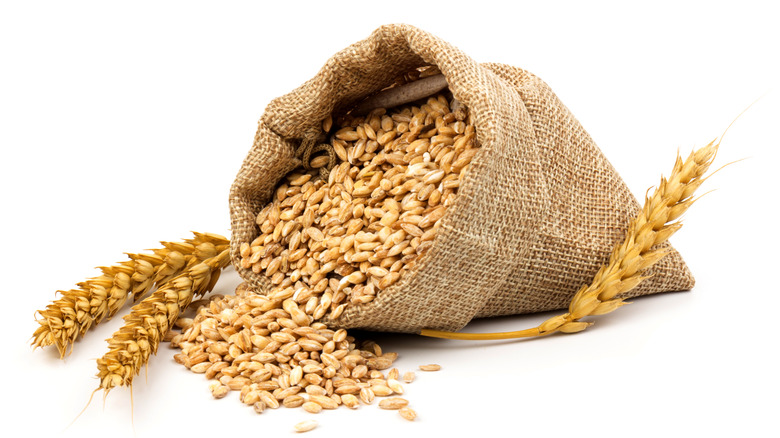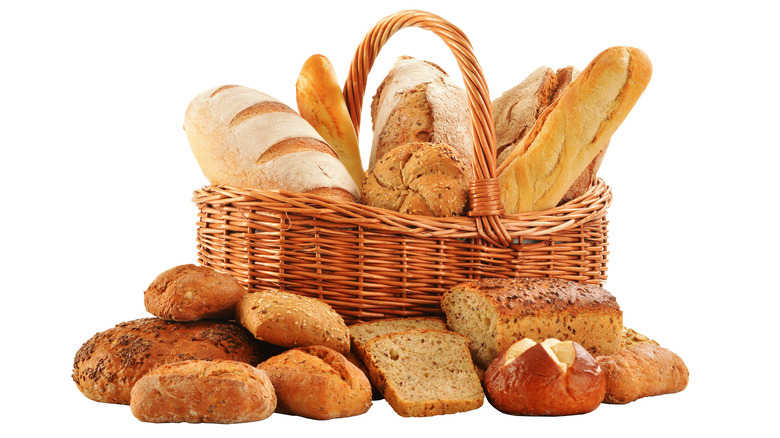Here's What Makes Whole Grain Different From Whole Wheat
Do you find yourself wandering the supermarket aisles mystified by food labels? With so many nutritional food claims, it's no wonder we're uncertain which types of food to purchase. Bread is no exception to this conundrum. Most of us know that white bread is a loaf that contains numerous additives and highly processed flour: These unhealthy ingredients may contribute to heart disease, obesity, and diabetes.
For this reason, many people are becoming more health-conscious, nixing the white bread and turning to healthier options instead. Whether you're shopping for tortillas, rolls, or crackers, they usually contain flour. Whether this is refined (processed) flour or not, it's up to you to decide which type is best for your diet.
Foods labeled "whole grain" and "whole wheat" line the store shelves, marketed as beneficial alternatives, but what is the difference between the two? Is one healthier than the other – and which one tastes better? These are questions you may be asking yourself as you peruse the aisle. Let's unravel the mystery behind these terms so you can be more informed during your next journey to the grocery store.
What is a whole grain?
Whether you are scanning cereal boxes, bread, or other bakery items, it's essential to know the difference between "whole grain" and "whole wheat." Whole grains contain all three parts of the grain kernel: the harvested grain's bran, germ, and endosperm. These unrefined grains are not broken apart, allowing them to retain and provide you with the most nutrients. Whole grains are incorporated as an ingredient in foods such as loaves of bread containing whole-wheat flour or barley. They can also come in the form of standalone food items like quinoa, brown rice, or oatmeal.
Foods and ingredients in this group are an excellent source of complex carbohydrates that stave off hunger for longer. They fuel the body with fiber, iron, B-vitamins, magnesium, and other key vitamins and minerals. These grains also contain high levels of antioxidants that have anti-aging benefits and fight free radical damage.
Whole grains provide an abundance of other health benefits, too. They help reduce the risk of chronic diseases, especially heart disease, and support healthy digestion, weight management, and glycemic health. Whole grains also contain folate, an essential B-vitamin that promotes a healthy pregnancy.
100% whole wheat is whole grain
Now that you're familiar with the term "whole grain," let's dive into the specifics of "whole wheat." According to the U.S. Food and Drug Administration (FDA), "whole wheat flour should be considered a whole grain flour because it contains all the parts of the grain." Foods labeled "whole wheat" have not been mixed with other grains. The critical point to remember is the word "whole." If this word is absent from the label, then the product is essentially a blend of refined and whole wheat grains. These blended foods do not guarantee the abundance of nutrients that "whole grain" and "whole wheat" foods do.
We know that all apples are fruit, but not all fruits are apples. The same is true with whole grains and whole wheat. All whole wheat is whole grain, but not every whole grain is whole wheat.
Certain whole grains also provide more dietary fiber than whole wheat alone, as the different grains offer various nutrients. Whole wheat also contains gluten, so seek gluten-free whole wheat varieties if you're gluten-sensitive.
And whether you're gluten-sensitive or not, you should always take a peek at the ingredient list. If the first ingredient reads "whole wheat" or "whole grain," you're on the right track. Also, observe the fiber content. Food with a higher fiber content is usually the better choice. Whole grain and whole wheat foods are also part of a healthy diet that reduces the risk of certain diseases. As long as your bread is made from 100% whole grains, you can rest assured you've chosen the best loaf.


